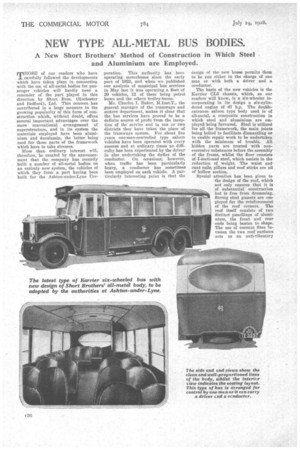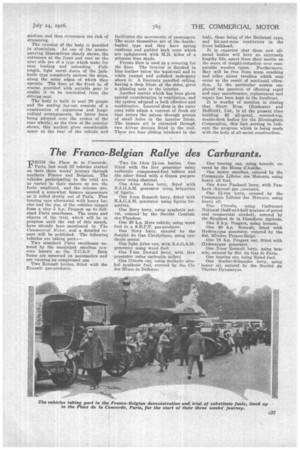NEW TYPE ALL-METAL BUS BODIES.
Page 58

Page 59

If you've noticed an error in this article please click here to report it so we can fix it.
A New Short Brothers' Method of Construction in Which Steel and Aluminium are Employed.
THOSE of our readers who have carefully followed the developments which have taken place in connection with the use of all-metal bodies for passenger vehicles will hardly need a reminder of the part played in this direction by Short Bros. (Rochester and Bedford), Ltd. This concern has contributed in a large measure to the growing popularity of this form of construction which, without doubt, offers several important advantages over the more conventional arrangement of superstructure, and in its system the materials employed have been aluminium and duralumin, the latter being used for those parts of the framework which have to take stresses.
More than ordinary interest will, therefore, be created by the announcement that the company has recently built a number of all-metal bodies on an entirely new system, the vehicles of which they form a part having been built for the Ashton-under-Lyne Cor
poration. This authority has been operating motorbuses since the early part of 1923, and when we published our analysis of municipal bus services in May last it was operating a fleet of 20 vehicles, 12 of them being petrol buses and the others trolley-buses.
Mr. Charles L Baker, M.Inst.T., the general manager of the tramways and motors department, makes it clear that the bus services have proved to be a definite source of profit from the inception of the service and in one or two districts they have taken the place of the tramways system. or about five years one-man-controlled type saloon vehicles have been operated with every success and at ordinary times no difficulty has been experienced by the driver in also undertaking the duties of the conductor. On occasions, however, when traffic has been particularly heavy, a conductor has sometimes been employed on each vehicle. A particularly interesting point is that the design of the new buses permits them to be run either in the charge of one man or with both a driver and a conductor.
The basis of the new vehicles is the Karrier Cr...9 chassis, which, as our readers will know, is a six-wheeler incorporating in its design a six-cylindered engine of 47 h.p. The doubleentrance saloon type body used is of all-metal, a composite construction in which steel and aluminium are employedbeing favoured. Steel is utilized for all the framework, the main joints being bolted to facilitate dismantling or to enable repair work to be undertaken with the minimum of trouble. All hidden parts are treated with noncorrosive substances before the assembly of the frame, whilst the floor consists of 1-sectioned steel, which assists in the reduction of weight. The waist and cant rails, pillars and roof sticks are all of hollow section.
Special attention has been given to the design of the roof, which not only ensures that it is of substantial construction but is free from drumming. Strong steel gussets are employed for the reinforcement of the roof corners. The roof itself consists of two distinct panellings of aluminium, the front and rear ends being beaten to shape. The use of coconut fibre between the two roof surfaces acts as an anti-vibratory. medium and thus overcomes me risk of drumming.
The exterior of the body is panelled in aluminium. As one of the accompanying illustrations clearly shows, the entrances at the front and rear on the near side are of a type which make for easy loading and unloading. lulllength, light metal doors of the jackknife type completely enclose the steps, along the outer edges of which they operate. The door at the front is, of course, provided with suitable gear to enable it to be controlled from the driving seat.
The body is built to seat 26 people and the seating lay-out consists of a combination of transverse and longitudinal arrangements, the latter form being adopted over the arches of the rear wheels; as the view of the interior shows, this method gives considerable space at the rear of the vehicle and facilitates the movements of passengers. The seats themselves are of the doublebucket type and they have spring cushions and padded back rests which are upholstered with ALB. hides of a princess blue shade.
Ferodo fibre is used is a covering for the floor. The interior is finished in blue leather below the waist-rail and in white enamel and polished mahogany above it. A lincrusta panelled ceiling, having a deep frieze at the sides, gives a pleasing note to the interior.
Another matter which has been given Special consideration is ventilation, and the system adopted is both effective and unobtrusive. Louvred slots in the outer cant rails admit a current of fresh air that enters the saloon through groups of small holes in the interior frieze. The impure air is extracted through two Airvae devices fitted in the roof. There are four sliding windows in the body, these being of the Beelawat type, and hit-and-miss ventilators in the front bulkhead.
It is expected that these new all. metal bodies will have an extremely lengthy life, apart from their merits on the score of weight-reduction over comparable wooden types. Furthermore, they will be free from seam cracking and other minor troubles which may occur as the result of continual vibration. In the particular system emPloyed the question of effecting rapid and easy maintenance, replacement and repair has been kept to the forefront.
It is worthy of mention in closing that Short Bros. (Rochester and Bedford), Ltd., is at the present time building 42 all-metal, covered-tap, double-deck bodies for the Birmingham Corporation, this fact serving to•indicate the progress which is being made with the body of all-metal construction.












































































































